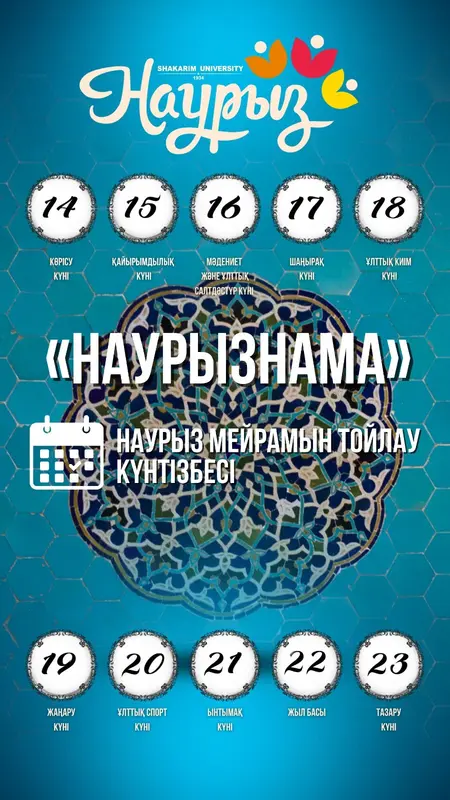INTERNATIONAL NAURYZ DAY IS APPROACHING!

The entire Turkic world, comprising nearly 400 million people, is eagerly awaiting the arrival of Nauryz!
Our Nauryz has deep roots in the millennia-old history of Eastern peoples. It is associated with cyclical changes in nature, the renewal of life, traditions of communication, and unity. While the peak of the celebration falls on March 21-22, in reality, it begins long before these dates. A whole system of preparatory rituals takes place, in some ways resembling the two-week celebration of the Chinese New Year, which also lasts for two weeks.
Stages of preparation for Nauryz:
March 14 – Kórisu Kuni (Day of Embrace and Reunion) - This is not just a gesture but a profound symbol: renewing relationships, forgiving old grievances, and restoring good connections. In Chinese culture, before the Chun Jie festival, people also visit relatives and loved ones, tidy up their homes, and clear their minds.
Jön-Joralgı – Mutual Assistance and Preparation - Before Nauryz, it is customary to help each other, clean homes, yards, and streets. People repay debts, give gifts, and assist the less fortunate—just as the Chinese cleanse their lives before the New Year, striving to enter the new cycle without burdens or conflicts.
Shezhire Kuni – Day of Ancestral Remembrance - On this day, people honor their departed relatives and express gratitude to the older generation for their contributions to family and society. This is similar to the Chinese Qingming Festival (清明节, Tomb-Sweeping Day), when families visit ancestral graves to pay respects.
Nauryz Köje – Preparing the Main Festive Dish - In the days leading up to the holiday, women prepare Nauryz Köje, a ritual dish made from seven ingredients symbolizing abundance, health, and prosperity. Similarly, before the Chinese New Year, special dishes are prepared—such as dumplings (jiaozi, 饺子), Peking duck, or sweet rice balls (tangyuan, 汤圆)—each carrying deep symbolism.
March 21-22 – The Main Days of the Celebration:
Spring Equinox – A Point of Rebirth - On this day, light and darkness are in perfect balance, nature fully awakens, and astronomical spring begins. The Chinese New Year is also closely linked to nature’s transformation, the awakening of life, and new beginnings.
Festive Gatherings - Cultural performances, purification by fire and water—traditional practices mark the start of a new life cycle.
Beyond March 22 – The Continuation of Nauryz:
Nauryz is not a single-day event but a full cycle that continues until April.
Qaiyrymdylyq Kuni – Day of Good Deeds - People engage in charitable activities, helping orphans, the elderly, and those in need. During Chun Jie in China, it is also customary to give gifts to children and elderly family members and support those who require help.
Jas Urpaq Kuni – Youth Day - This day highlights the role of young people in shaping the country’s future through student conferences, educational forums, and youth initiatives. China also has a day dedicated to the younger generation—a time when young people take on adult responsibilities.
Bereke-Birlik Kuni – Day of Unity and Harmony - Nauryz symbolizes peace and friendship among different peoples. This day features ethnic festivals, the strengthening of international ties, and the reaffirmation of the idea of "bir shanyraq astynda" (living under one roof). In China, a similar tradition brings families together for a meal, even if they live in different parts of the country.
Sports and Cultural Competitions - The joy of welcoming spring extends through various traditional games and performances.
Nauryz and the Chinese New Year: What Unites Them?
Laws of Nature: Both celebrations are directly connected to natural cycles.
Purification: To step into a new life, it is important to cleanse our homes and souls, letting go of old grievances.
Family Values: Both holidays emphasize family traditions and generational continuity.
Doing Good Deeds: Kindness and charity are the core principles of both celebrations.
Deep Philosophy: Nauryz and Chunjie are not just joyful festivities but also holidays that invite reflection on the meaning of life.
Why is Nauryz Important Today?
In an era of global challenges, Nauryz reminds us that everything is cyclical. Any hardship passes, winter is always followed by spring, and renewal comes after difficulties.
Nauryz represents unity, respect for traditions, progress, and forward movement.
May this Nauryz be a time of renewal, a fresh start, and new opportunities for all of us!
